ISSN ONLINE(2278-8875) PRINT (2320-3765)
ISSN ONLINE(2278-8875) PRINT (2320-3765)
Mr. S. Srikanth 1, Dr. V. Jeyalakshmi2
|
| Related article at Pubmed, Scholar Google |
Visit for more related articles at International Journal of Advanced Research in Electrical, Electronics and Instrumentation Engineering
The purpose of this paper is to design a lowpass-bandpass diplexer printed on FR-4 substrate. The matching circuit design of a lowpass-bandpass diplexer may be a challenge in conventional designs because a wideband (from zero frequency to approximately the cutoff frequency of the lowpass filter) open condition is required to achieve in bandpass channel circuit. This paper proposes a new lowpass-bandpass diplexer that involves using a simple matching design that can easily meet the required matching condition in each channel circuit. For the lowpass channel, the simulated in-band insertion loss and cutoff frequency are less than 0.1dB and approximately 1.5 GHz, respectively. For the bandpass channel, the simulated minimal insertion loss and center frequency are approximately 3.2dB and 2.4GHz respectively. The simulated isolation between the two operating bands is approximately 32 dB. The tested insertion loss of the lowpass filter and bandpass filter is 3.2dB and 8.92dB respectively. The tested isolation between the two operating bands is approximately 40dB.
Keywords |
| Bandpass, diplexer, filter, lowpass, microstrip. |
I. INTRODUCTION |
| DIPLEXERS are key devices in wireless communication system. In most diplexers such as [1]–[3], bandpass response for favorable selectivity has been designed in each transmission path. However, some mixer applications for dividing intermediate frequency (IF) and local oscillator (LO) frequency require managing lowpass |
| and bandpass signals by using, for instance, a low-loss transmission with suppression of harmonics and favorable bandpass selectivity in different operating bands. To meet low-loss transmission requirements with a suppression of harmonics and to obtain favorable band selection, which can be achieved by using a lowpass filter and bandpass filter (BPF), respectively, the lowpass-bandpass diplexers proposed by [4] and [5] may be required. Microstrip is a type of transmission line which is fabricated using Printed Circuit Board (PCB) and it is used to convey microwave frequency signal. Generally, the junction circuit (matching circuit) of a diplexer is a critical part of the design because the matching circuit may provide an easy independent design for each channel filter. The matching circuit design of a diplexer without a wideband bandpass response in each channel is usually not a problem, where in the matching circuit can be easily achieved by adopting the well-known T-junction design such as those that have been proposed by [1]–[3] and [6]. However, a wideband open condition (from zero frequency to approximately the cutoff frequency of the lowpass filter) is necessary when designing a lowpass-bandpass diplexer, and it may not be easily achieved by the conventional T-junction design. Based on the literature review, no simplified and clear procedure exists for the matching circuit design of a lowpass-bandpass diplexer. A simplified design procedure may circumvent time-consuming optimization when designing the matching circuit in a lowpass-bandpass diplexer. Therefore, this study proposes a new lowpassbandpass diplexer structure with a simple and systematic method for facilitating the design process. |
II. COMPARISON OF THE PROPOSED LOWPASSBANDPASS DIPLEXER AND THAT OF A PREVIOUS STUDY |
| In the previous paper, the design of microstrip lowpassbandpass diplexer was fabricated on a Rogers RO4003C substrate with a thickness of 1.524 mm, a relative dielectric constant of 3.55,and a loss tangent of 0.006.By using the Rogers RO4003C ,the size of the entire filter is large as well as the cost is high. |
| This paper presents a design of microstrip lowpassbandpass diplexer was tested on a FR-4 substrate with a height of 1.6 mm,a relative dielectric constant of 4.3 and a loss tangent of 0.025.As the relative dielectric constant is higher than the RO4003C , the size and the cost is reduced. By varying the length and width of the strip, the passband insertion loss is improved in the bandpass section. By comparing the previous paper, the length of the diplexer is reduced to 6% and lowpass insertion loss is reduced to 40%.The fabrication cost is also lesser than the previous one. |
III. PROPOSED LOWPASS-BANDPASS DIPLEXER |
| The proposed lowpass-bandpass diplexer configuration composed of one fifth-order lowpass filter using opencircuited stubs, as suggested in Chapter 5 of [7], and one fifth-order coupled-resonator BPF using a coupled-line feed structure, as suggested in [7, Ch.8]. This paper presents a simple design for the matching requirement of a lowpass-bandpass diplexer. Thus, the lowpass filter and BPF of the diplexer can be independently designed. |
| For the lowpass filter suggested in [7, Ch.5], the open stubs(T1 ,T3 , T3′, and T5) can be transformed into shunt capacitors,and the series transmission lines with high characteristic impedance (T2 and T4) are close to the series inductors. The design equations of a fifth-order lowpass filter can be written as |
 |
 |
| where fc is the cutoff frequency. and are the length of the shunt open stub and series high-impedance transmission line, respectively .Here C3, can be achieved using the two parallel stubs T3and T3 ′:C1 and C5 can be achieved by using the two stubs T1 and T5, respectively; L2 and L4 can be achieved by using the two series transmission lines T2 and T4 with high characteristic impedances. Based on the proposed design, the lowpass filter and BPF can be separately designed, and the design procedure can be easily followed. |
| The proposed diplexer in this study was tested on FR-4 substrate with a height of 1.6 mm, a relative dielectric constant of 4.3, and a loss tangent of 0.025. Fig. 1 shows the layout and photograph of the proposed lowpassbandpass diplexer using FR-4 substrate . According to the design method described in this section, lowpass filter and BPF can be designed separately. The lowpass filter is designed for a fifth-order Chebyshev frequency response. The cutoff frequency is approximately 1.5 GHz.Therefore, the required lumped parameters shown in Fig. 1 are C1=C5=3.62pF, L2=L4=6.52nH and C3=5.39pF. The approximately equivalent transmission-line physical length or characteristic impedance of each lumped parameter can be calculated using (1) and (2). The whole dimensions of previous work is converted to FR-4. In the bandpass channel ,a coupled resonator BPF that involves using a coupled feedline structure, as suggested in [7, Ch.8], is designed for a fifth-order Chebyshev response; its center frequency and 3 dB fractional bandwidth are designed approximately 2.4 GHz and 4.5%. |
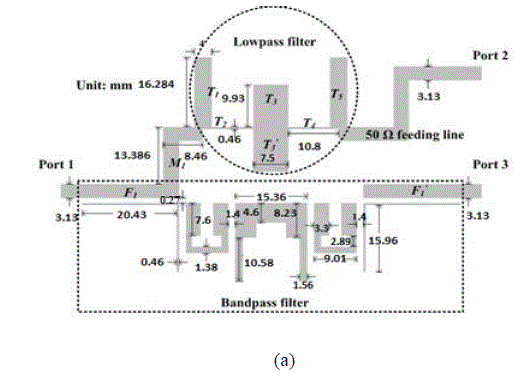 |
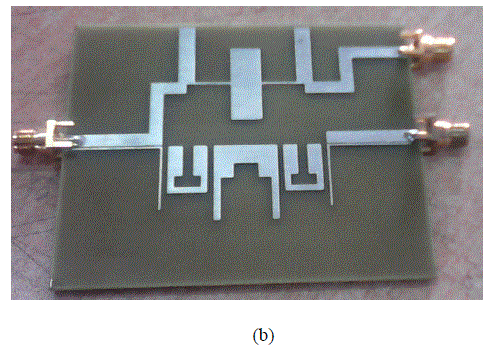 |
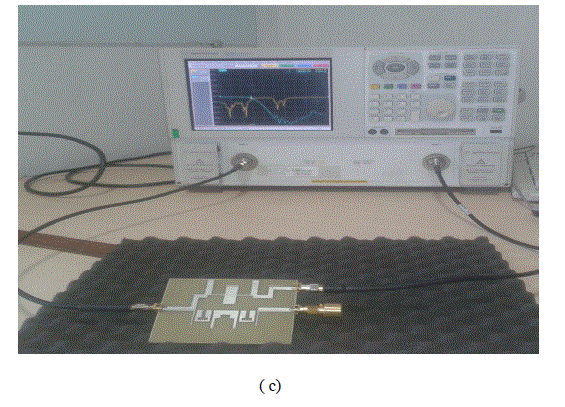 |
| Fig. 1. Proposed lowpass-bandpass diplexer (a) Layout (b) Photograph. (c) Tested photograph. |
| Fig.2 shows the simulated scattering parameters of the proposed circuit. For the lowpass channel, the measured in-band insertion loss (-20 logâÂÂS21âÂÂ) is less than 0.1 dB, and the measured cutoff frequency is approximately 1.5 GHz. For the bandpass channel, the measured center frequency is approximately 2.4 GHz, the measured minimal insertion loss (-20logâÂÂS31âÂÂ) is approximately 3dB. The measured isolation (-20logâÂÂS32âÂÂ) in the two passbands is approximately 32dB. Table I shows a comparison performance between this work and two previous works of lowpass-bandpass diplexer. |
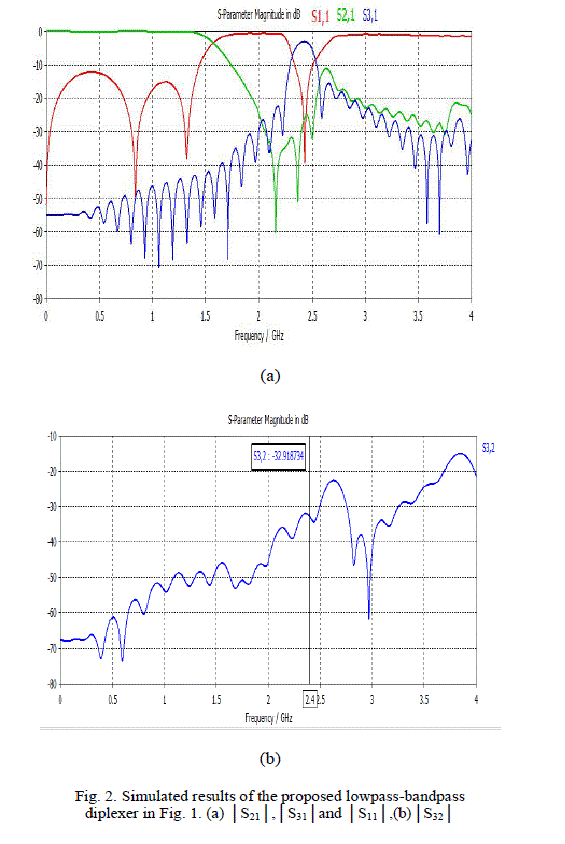 |
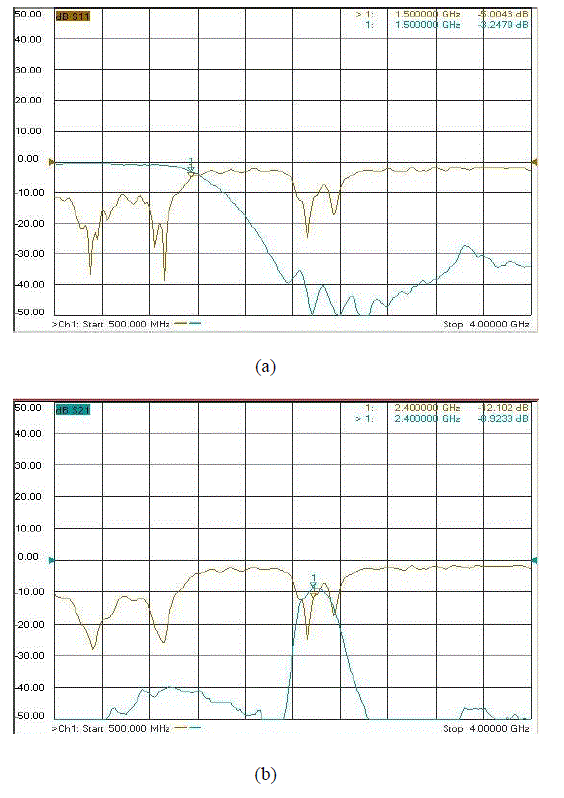 |
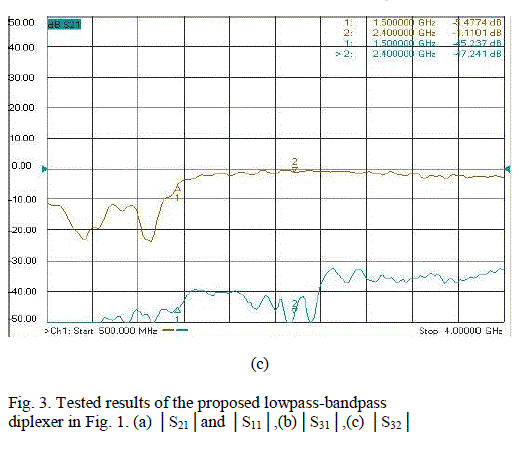 |
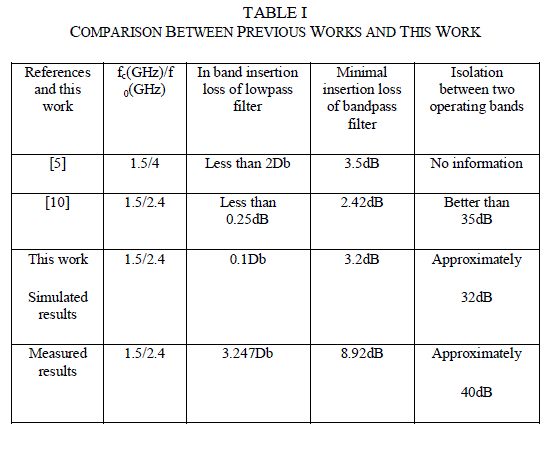 |
IV. CONCLUSION |
| This paper proposes a new lowpass-bandpass diplexer for low-loss transmission with suppression of harmonics and favorable selectivity in different operating bands, respectively. Based on the proposed matching design, the lowpass-bandpass diplexer can independently design lowpass and bandpass band circuits, which may facilitate the design process. The proposed circuit was carefully designed and tested .The size of the diplexer can be reduced for future implementation. The lowpass section will be used in digital sound broadcasting and the bandpass section will be used in Zig-bee applications. |
References |
|